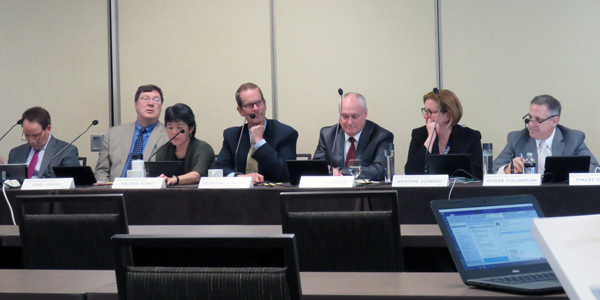By Jason Fordney
Western Energy Imbalance Market (EIM) leaders on Tuesday approved rule changes that would allow EIM balancing areas to manually adjust load forecasts during market operations to ensure the grid can support system conditions.
The five-member EIM Governing Body at a meeting in Vancouver, Canada, approved the ISO’s proposed “Imbalance Conformance” rule changes, which allow operators to manually update the load forecast to account for changing grid conditions. Conformance is used to account for errors in the load forecast, CAISO Market Design Manager Brad Cooper told the body.
“A lot of times it is [used] because of supply deviations, whether it is generators deviating from their dispatch or renewable energy forecast error,” Cooper said during a presentation. The body’s decision conforms with CAISO’s final proposal issued in mid-March, which clarifies that ISO and EIM balancing area operators can make imbalance adjustments, a clarification CAISO said it was making in the interest of transparency.
The proposal also includes alterations to the “Imbalance Conformance Limiter,” an ISO software tool designed to prevent price spikes caused by imbalance conformance adjustments. The adjustments can be imprecise, CAISO said, and the limiter keeps the market from trying to dispatch more supply than is available in a particular dispatch interval.
The Governing Body unanimously approved the tariff clarifications under its primary authority, while the Imbalance Conformance Limiter changes fall under the body’s advisory role. CAISO plans to seek approval from its Board of Governors on May 16 and then submit them to FERC.
The ISO said the changes were approved by all stakeholders, including Arizona Public Service, the Department of Market Monitoring, Pacific Gas and Electric, Public Generating Pool, Powerex, Southern California Edison and the Six Cities group of Southern California utilities.
CAISO initially announced the rule changes last November. Also called “load bias,” the practice has drawn comment from some market participants that note CAISO is increasingly relying on it, particularly in early morning and evening hours when solar generation comes online and offline. (See ‘Load Bias,’ Prices Rise in CAISO Q3.)
In its proposal, the ISO noted that imbalance conformance is imprecise because it uses an aggregated value since manually updating all the supply deviations every five minutes with 100% accuracy is not possible. Using the load forecast allows the conformance adjustments to be spread evenly across the system.
Two Spots to Open
EIM Governing Body Chairman Doug Howe is due to step down from the panel at the end of June, when his first term ends. (See ‘Hesitancy’ Around Western RTO, EIM Chair Says.) Body member Carl Linvill’s term also ends on June 30, and it is not known whether he will seek re-nomination. Other members include Vice Chairs Valarie Fong and John Prescott, whose terms end in 2019, as well as Kristine Schmidt, whose term runs out in 2020. All five are original members of the panel overseeing the regional market, which is expected to incorporate CAISO’s day-ahead market functions, a major change. (See CAISO Says Changes Will Better Match Forecasting, Demand.)
CAISO Regional Affairs Manager Peter Colussy told the board that an eight-member nominating committee and a third-party executive search firm are looking nationwide to fill two positions on the board. In-person interviews for new EIM Governing Body candidates are set for May 10-11 in Phoenix, Ariz. Relevant expertise is needed, as well as a familiarity with the Western Interconnection, and candidates must be independent of participants in the ISO and EIM markets or those who advocate for certain positions in the ISO stakeholder process, Colussy said in a presentation.
The approved slate of candidates is due for approval by the Governing Body on June 20. Terms are three years, beginning July 1 of each year and ending on June 30.
In January, the EIM Governing Body rejected a proposal that would have changed how the board nominates members. (See EIM Body Tables Nominating Process Changes.) The rejected proposal would have eliminated the EIM Nominating Committee’s obligation to use an executive search firm to help fill Governing Body vacancies, instead encouraging committee members to rely more on their own contacts.





